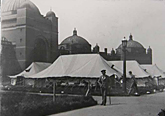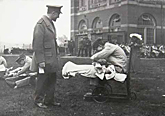
The First World War may have been a severe setback to academic study but it enabled the university to thrive as a military hospital.
In August 1914, the University buildings at Edgbaston were taken over by the military authorities as the Ist Southern General Hospital under a territorial scheme that had been prepared some years earlier. The whole of the site was handed over to the War Office and, with many alterations, was converted into a great hospital.
The contents of the Great Hall were removed, workshops were dismantled; desks gave place to beds, undergraduates and gowns to nurses and hospital ‘blues’. The spirit of eager activity was replaced by one of suffering and repose.
At the end of the year there were more than 600 patients and accommodation for 800, figures that increased and extended rapidly from year to year, until, on January 1, 1918, there were 1,358 beds. At the end of the war, 64,000 patients had passed through the university quarters of the hospital which, by then, had been expanded into many sections.

There was a Royal visit on July 22 1915, when the King went round the wards and chatted with the patients. On special occasions such as the anniversary of the outbreak of war, visits of distinguished generals and the presentation of military honours, there were impressive parades of staff and patients in the hospital grounds. A Rowland Mason Memorial Hut, erected in August, 1917, became the venue for many varieties of entertainment for patients.
Two past adjutants of the Officers’ Training Corps (OTC) were killed in action in the first months of the war. Of the members of the senior staff, the only one qualified for active service was Professor Chatelain who after a winter in the trenches was taken ill and died in hospital. These were only the first in a sad tale of losses that mounted year by year and of which a permanent record endures in the University’s War Memorial, with more than 150 names of staff and students fallen in the war.
In addition to the men who fought, there were large calls on the staff from the technical side. Many of the professorate were occupied on war work, some of it of considerable importance in the research field. Professor Burstall was in charge of experiments in regard to the design of tank radiators. The Civil Engineering section under Professor Lea was engaged in studying the application of aluminium and light alloys in aircraft and engine parts. Professor Frankland was Deputy Inspector of High Explosives and responsible for the Birmingham area. Working under him was a large staff experimenting in poison gases. Sir Oliver Lodge was appointed a member of the Admiralty Board of Invention and Research in 1915 and his services were especially valuable in the science of sound and the development of wireless telegraphy. Others whose expert abilities were utilised in military or government departments included Professors Cadman and Frank Tillyard, and Sir William Ashley.
No academic work was done at Edgbaston during the war years. Practically everything was in abeyance ‘for the duration’. With so many engaged in fighting or military occupations, the Mason College buildings were adequate for teaching needs and for the nucleus of student life centred at Edmund Street. Some classes were held at the Municipal Technical School, but generally the war was a severe setback to the pursuit of academic studies. After the Armistice, the hospital was gradually given up, and a great deal of expense was necessary to put it all right again.
Extract from The University of Birmingham: Its History and Significance, by Eric W Vincent and Percival Hinton. Birmingham Cornish Brothers Ltd, 1947.